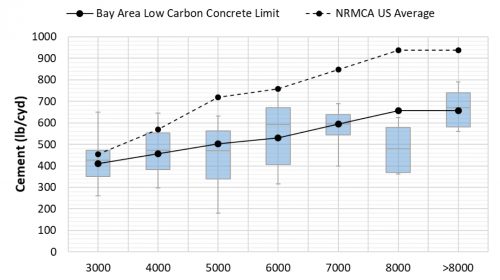The Marin County (Calif.) Board of Supervisors unanimously adopted an ordinance that adds a low-carbon concrete specification to the county’s building code, effective January 2020. The new code applies to foundation, column or slab mix designs for private and public construction projects in unincorporated areas, and includes pathways for compliance with either reduced cement levels or lower-emission supplementary cementitious materials. Exemptions address higher cement contents typical of structural precast and lightweight aggregate concrete mixes.
The ordinance is the result of Marin County’s “Bay Area Low-Carbon Concrete Codes Project,” which aims to reduce embodied emissions in the built environment by creating local specifications and model policies for low embodied-carbon concrete. Funded through the Bay Area Air Quality Management District’s Climate Protection Grant Program, the project has teamed a Marin County stakeholder group with StopWaste, a public agency serving neighboring Alameda County; structural engineer Bruce King, P.E.; design firm Arup; and, the Carbon Leadership Forum, whose charter members include San Francisco Bay Area ready mixed market leader Central Concrete Supply. Future target outcomes are a) four pilot projects receiving technical assistance to apply the low embodied-carbon concrete specifications by 2022; and, b) formation of a Bay Area Concrete Working Group as an extension of the Embodied Carbon Network.
In response to the ordinance passage, Molly Culton, conservation organizer for Sierra Club California, noted: “While a lot of work has been done to reduce operational emissions in buildings, addressing embodied emissions is the next frontier. With this concrete ordinance, Marin County has established itself as a leader in addressing greenhouse gas emissions in the built environment. We anticipate other local governments in the Bay Area and beyond will pass similar policies.”
The Bay Area Low-Carbon Concrete Code is part of a larger wave of policies that aim to address embodied carbon emissions in building materials. Earlier this year, Portland, Ore., adopted a program that requires all concrete used in city projects to disclose emissions through a product-specific, third-party verified environmental product declaration.
CODIFIED CEMENT OPTIMIZATION
Bay Area Low-Carbon Concrete vs. NRMCA Industry Average mix designs
National Ready Mixed Concrete Association and Structural Engineers Association of Northern California (SEANOC) data support principal benchmarks that the Bay Area Low Carbon Concrete Code stakeholders group referenced in proposals to the Marin County Board of Supervisors. A key charter-code provision reflects an optimization schedule in which portland cement volumes are reduced at 10 percent, 20 percent and 30 percent in mixes for concretes of ≤ 3,000 psi, 4,000 psi and ≥ 5,000 psi compressive strength. The schedule is a) based on U.S. industry average cement contents documented in the NRMCA Life Cycle Assessment for ready mixed concrete; and, b) validated in compressive strength test results SEANOC obtained in a survey of 226 concretes designed with portland cement as the sole binder or a range of portland cement + supplementary cementitious materials.
SOURCES: Bay Area Low-Carbon Concrete Codes Project; NRMCA
